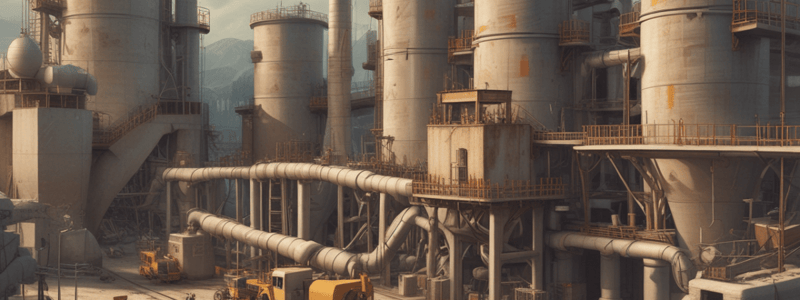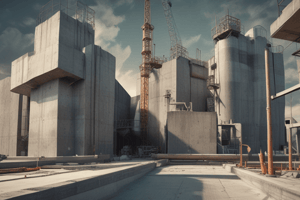Podcast
Questions and Answers
What is the primary function of silica in cement?
What is the primary function of silica in cement?
- To increase the strength of cement (correct)
- To provide binding properties to cement
- To reduce the setting time of cement
- To provide tensile strength to cement
What is the term for the process by which cement hardens over time?
What is the term for the process by which cement hardens over time?
- Curing
- Hardening (correct)
- Setting
- Hydration
Which of the following is a property of cement that refers to its ability to withstand sudden and intense impacts?
Which of the following is a property of cement that refers to its ability to withstand sudden and intense impacts?
- Hardness
- Strength
- Soundness (correct)
- Toughness
What is the byproduct of the reaction between cement and water?
What is the byproduct of the reaction between cement and water?
Which of the following is a step involved in the wet process of manufacturing cement?
Which of the following is a step involved in the wet process of manufacturing cement?
What is the main function of limestone in cement?
What is the main function of limestone in cement?
Which of the following ingredients is responsible for the early setting of cement?
Which of the following ingredients is responsible for the early setting of cement?
What is the purpose of adding gypsum to cement?
What is the purpose of adding gypsum to cement?
What is the term for the amount of heat produced during the hydration of cement?
What is the term for the amount of heat produced during the hydration of cement?
What is the property of cement that refers to its ability to resist excessive volume expansion?
What is the property of cement that refers to its ability to resist excessive volume expansion?
What is the primary role of alumina in cement?
What is the primary role of alumina in cement?
During the wet process of manufacturing cement, what is the purpose of the grinding operation?
During the wet process of manufacturing cement, what is the purpose of the grinding operation?
What is the primary reason why cement Exhibits a higher heat of hydration during the early stages of hydration?
What is the primary reason why cement Exhibits a higher heat of hydration during the early stages of hydration?
Which of the following raw materials is responsible for the formation of a large amount of calcium hydroxide during the hydration of cement?
Which of the following raw materials is responsible for the formation of a large amount of calcium hydroxide during the hydration of cement?
What is the primary consequence of excessive heat of hydration during the setting of cement?
What is the primary consequence of excessive heat of hydration during the setting of cement?
Flashcards are hidden until you start studying
Study Notes
Raw Materials of Cement
- Limestone (CaCO3) is the primary source of calcium oxide
- Clay (SiO2, Al2O3, Fe2O3) is the primary source of silicon dioxide, aluminum oxide, and iron oxide
- Other raw materials include silica, alumina, and iron oxide
Ingredients of Cement and their Functions
- Calcium oxide (CaO): provides strength and binding properties
- Silicon dioxide (SiO2): provides durability and resistance to weathering
- Aluminum oxide (Al2O3): helps in regulating setting and hardening
- Iron oxide (Fe2O3): provides color and strength
- Gypsum (CaSO4.2H2O): regulates setting and hardening
Wet Process of Manufacturing of Cement
- Crushing and grinding of raw materials
- Mixing of raw materials in a kiln
- Burning at high temperatures (1450°C) to produce clinker
- Grinding of clinker with gypsum to produce cement
Properties of Cement
Setting and Hardening
- Cement sets and hardens when mixed with water
- Setting: formation of a hard, rigid mass
- Hardening: strengthening of the set material over time
Heat of Hydration
- Exothermic reaction between cement and water
- Releases heat, which can cause cracks in concrete
Soundness of Cement
- Ability of cement to resist volumetric changes
- Ensures that concrete does not shrink or expand excessively
Raw Materials of Cement
- Limestone (CaCO₃) is the primary component, providing calcium oxide (CaO)
- Clay (SiO₂, Al₂O₃) provides silicon dioxide (SiO₂) and aluminum oxide (Al₂O₃)
- Silica (SiO₂) is present in the form of sand or quartz
- Iron oxide (Fe₂O₃) is typically present in small amounts
- Gypsum (CaSO₄.2H₂O) is added to regulate setting time
Ingredients of Cement and their Functions
- Calcium oxide (CaO): provides strength and hardness
- Silicon dioxide (SiO₂): helps in strengthening and providing durability
- Aluminum oxide (Al₂O₃): assists in regulating setting time
- Iron oxide (Fe₂O₃): provides color and helps in regulating setting time
- Gypsum (CaSO₄.2H₂O): regulates setting time and provides workability
Wet Process of Manufacturing of Cement
- Crushing and grinding of raw materials to produce a uniform powder
- Mixing of raw materials in the desired proportion
- Grinding of the mixture into a fine powder, called raw meal
- Burning the raw meal in a rotary kiln at high temperature (1450°C)
- Cooling the resulting clinker
- Grinding the clinker with gypsum to produce cement
Properties of Cement
Setting and Hardening
- Setting: the process of cement changing from a liquid to a solid state
- Hardening: the process of cement becoming stronger and more durable over time
Heat of Hydration
- The heat generated during the hydration reaction between cement and water
- CaO + H₂O → Ca(OH)₂ + heat
- Heat of hydration affects the setting and hardening of cement
Soundness of Cement
- The ability of cement to withstand the forces of expansion and contraction without disintegrating
- Soundness is tested by measuring the expansion of a cement paste sample
Cement: An Overview
- Cement is a binding material used in construction.
Raw Materials
- The primary raw materials used in cement production are limestone, clay, and silica.
- Other raw materials include iron ore, bauxite, and gypsum.
Ingredients of Cement and their Functions
- Limestone (CaCO3): provides calcium oxide, essential for cement's binding properties.
- Clay (SiO2, Al2O3): provides silica and alumina, which react with calcium oxide to form cement.
- Silica (SiO2): helps to strengthen cement.
- Iron ore (Fe2O3): adds color and helps to strengthen cement.
- Bauxite (Al2O3): provides alumina, which reacts with silica to form cement.
- Gypsum (CaSO4): helps to regulate cement's setting time.
Wet Process of Manufacturing Cement
- The wet process involves mixing raw materials with water to form a slurry.
- The slurry is then fed into a klin, where it is heated to a high temperature, producing cement clinker.
- The clinker is then ground into a fine powder to produce cement.
Properties of Cement
Setting and Hardening
- Cement sets and hardens due to hydration reactions between cement particles and water.
- The setting process is complete when the cement has reached its final shape and strength.
Heat of Hydration
- The heat of hydration is the heat generated during the hydration reaction.
- It is an important factor in cement's strength and durability.
Soundness of Cement
- Soundness refers to cement's ability to withstand chemical reactions and maintain its strength.
- It is an important property of cement, as it affects the durability of structures.
Studying That Suits You
Use AI to generate personalized quizzes and flashcards to suit your learning preferences.




